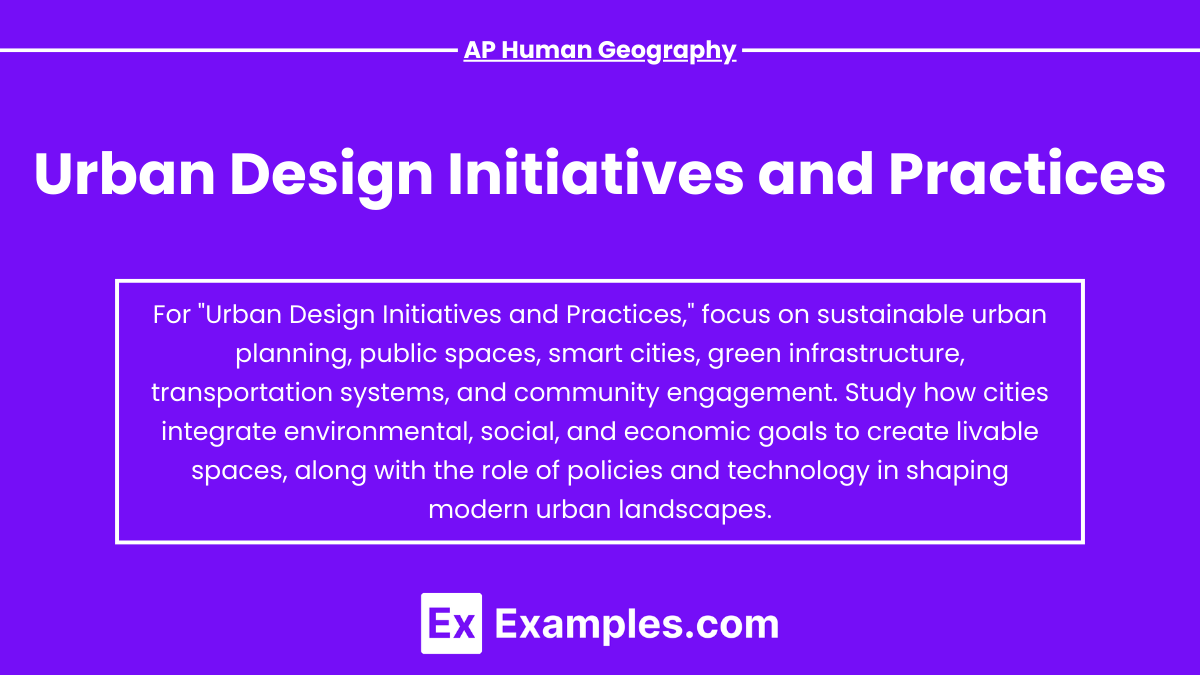Urban Design Initiatives and Practices in AP Human Geography explore how cities are planned and developed to meet the needs of growing populations while addressing sustainability, inclusivity, and functionality. This involves creating efficient transportation systems, managing resources, and designing spaces that foster community well-being. From historical planning models like Garden Cities to contemporary smart cities and transit-oriented development, urban design shapes the way people interact with their environment, impacting social equity, economic growth, and climate resilience in urban areas worldwide.
Learning Objectives
In studying “Urban Design Initiatives and Practices” for AP Human Geography, you should aim to understand the evolution of urban design, including key historical and contemporary movements like New Urbanism, Smart Cities, and Transit-Oriented Development. Focus on how urban planning addresses sustainability, social equity, and climate resilience. You should also analyze real-world examples of green infrastructure, affordable housing, and technological innovations in cities globally. Additionally, grasp the challenges cities face, such as economic pressures and resource distribution, to critically evaluate the effectiveness of these design strategies.
Urban Design Initiatives and Practices for AP Human Geography
Urban design refers to the planning and creation of cities, focusing on how built environments function, the relationship between people and places, and improving urban life quality. As part of the AP Human Geography curriculum, understanding urban design initiatives and practices involves exploring the ways in which cities are planned to address population growth, infrastructure needs, sustainability, and community well-being.
1. Historical Background of Urban Design
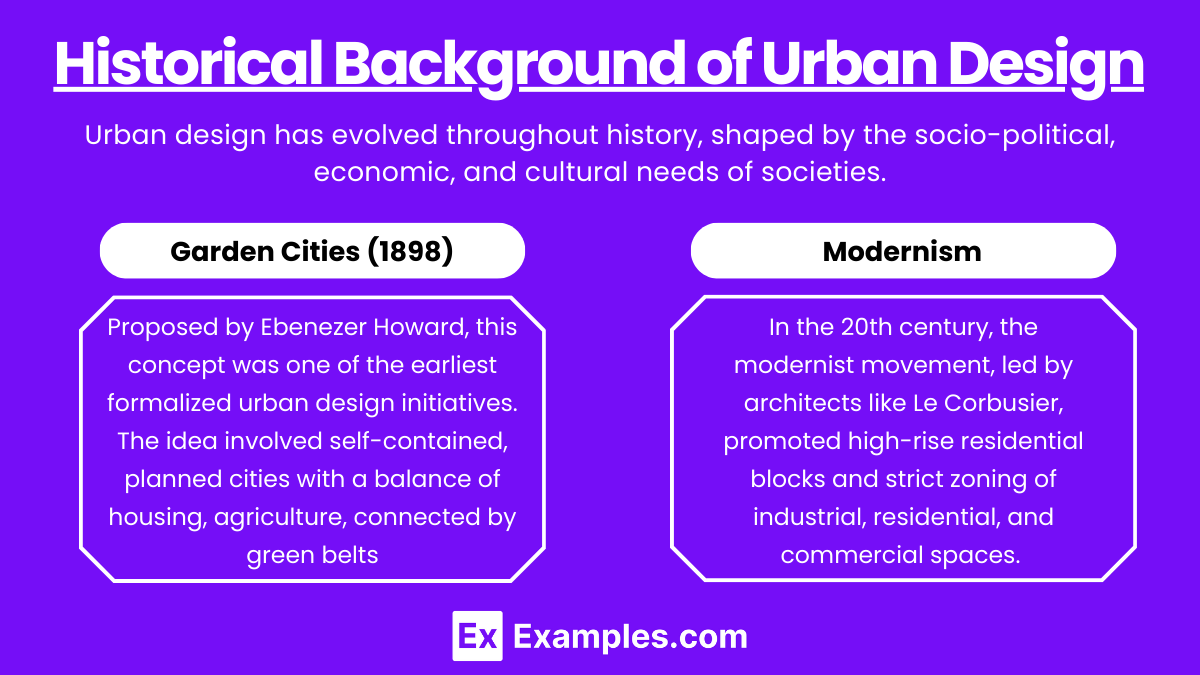
Urban design has evolved throughout history, shaped by the socio-political, economic, and cultural needs of societies. Ancient cities like Rome and Athens were meticulously planned with grids, open spaces, and infrastructures like aqueducts, but modern urban design, particularly post-Industrial Revolution, shifted toward managing rapid urbanization, pollution, and transportation issues.
- Garden Cities (1898): Proposed by Ebenezer Howard, this concept was one of the earliest formalized urban design initiatives. The idea involved self-contained, planned cities with a balance of housing, industry, and agriculture, connected by green belts.
- Modernism and the Le Corbusier Influence: In the 20th century, the modernist movement, led by architects like Le Corbusier, promoted high-rise residential blocks and strict zoning of industrial, residential, and commercial spaces. This influenced post-war urban planning, particularly in Europe and North America.
2. Contemporary Urban Design Practices
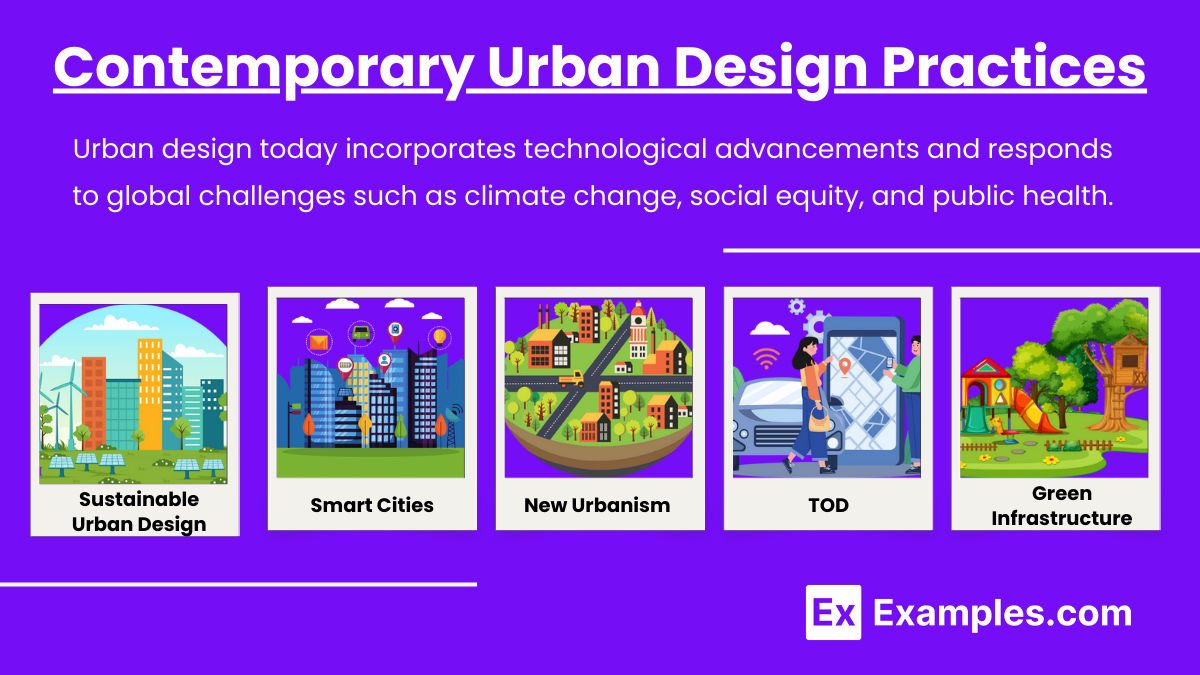
Urban design today incorporates technological advancements and responds to global challenges such as climate change, social equity, and public health. Some key contemporary urban design practices include:
- Sustainable Urban Design: Sustainability has become a cornerstone of modern urban planning. This approach focuses on reducing cities’ ecological footprints, improving energy efficiency, and incorporating renewable resources. Practices include the development of green buildings, energy-efficient public transportation systems, and water management strategies.
- Examples: Solar-powered buildings, bike lanes, electric public transport (e.g., in cities like Copenhagen), and green roofs.
- Smart Cities: This initiative integrates technology and data-driven management to improve efficiency, sustainability, and livability in urban areas. Smart cities use Internet of Things (IoT) devices to manage traffic, waste, water, and energy, while enhancing public services.
- Examples: Singapore and Barcelona have adopted smart city principles, using sensors to control energy consumption and smart transportation systems to manage traffic congestion.
- New Urbanism: A design movement that emerged in the 1980s, New Urbanism advocates for the return of traditional city planning principles, such as walkability, mixed-use development, and community-focused public spaces. The goal is to create more human-centric cities.
- Examples: Seaside, Florida, and Celebration, Florida, are models of New Urbanism, where homes, shops, and workspaces are located in close proximity, reducing dependence on cars.
- Transit-Oriented Development (TOD): TOD focuses on creating compact, walkable communities centered around high-quality public transportation systems. It aims to reduce car dependency, lower carbon emissions, and increase accessibility.
- Example: The city of Curitiba in Brazil is well known for its efficient bus rapid transit (BRT) system, which encourages people to live and work near transit stations.
- Green Infrastructure and Open Spaces: Urban design also emphasizes creating and maintaining green spaces to improve public health, reduce heat island effects, and provide recreation. Parks, green corridors, and urban forests are integral to this approach.
- Example: Central Park in New York City remains a key urban green space model, providing not only a recreational area but also an ecological haven within a bustling city.
3. Urban Design for Social Equity and Inclusivity
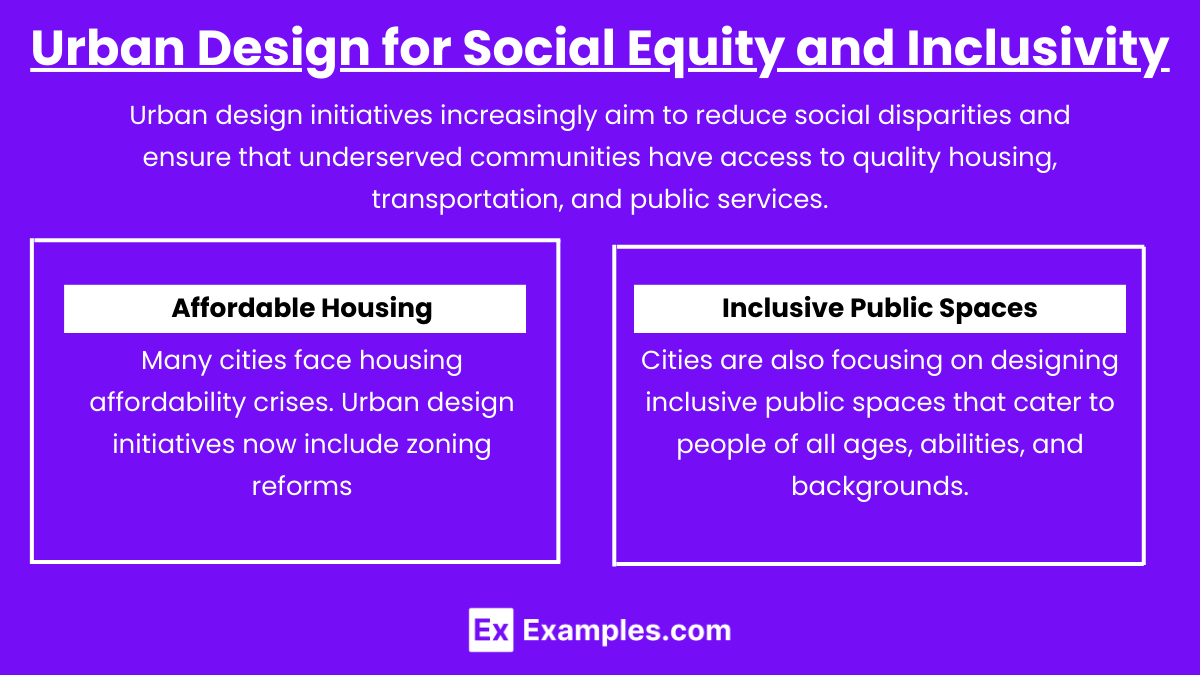
As cities expand, there is a growing focus on designing urban spaces that promote social equity, inclusivity, and public well-being. Urban design initiatives increasingly aim to reduce social disparities and ensure that underserved communities have access to quality housing, transportation, and public services.
- Affordable Housing and Mixed-Income Development: Many cities face housing affordability crises. Urban design initiatives now include zoning reforms and mixed-income housing to ensure that all residents have access to housing.
- Example: In cities like Vancouver and San Francisco, urban design includes regulations to ensure the provision of affordable housing within mixed-use developments.
- Inclusive Public Spaces: Cities are also focusing on designing inclusive public spaces that cater to people of all ages, abilities, and backgrounds. This includes the creation of pedestrian-friendly streets, plazas, and community hubs.
- Example: The High Line in New York City is a repurposed elevated railway line transformed into a public park, providing a unique space for social interaction and engagement.
4. Global Initiatives in Urban Design
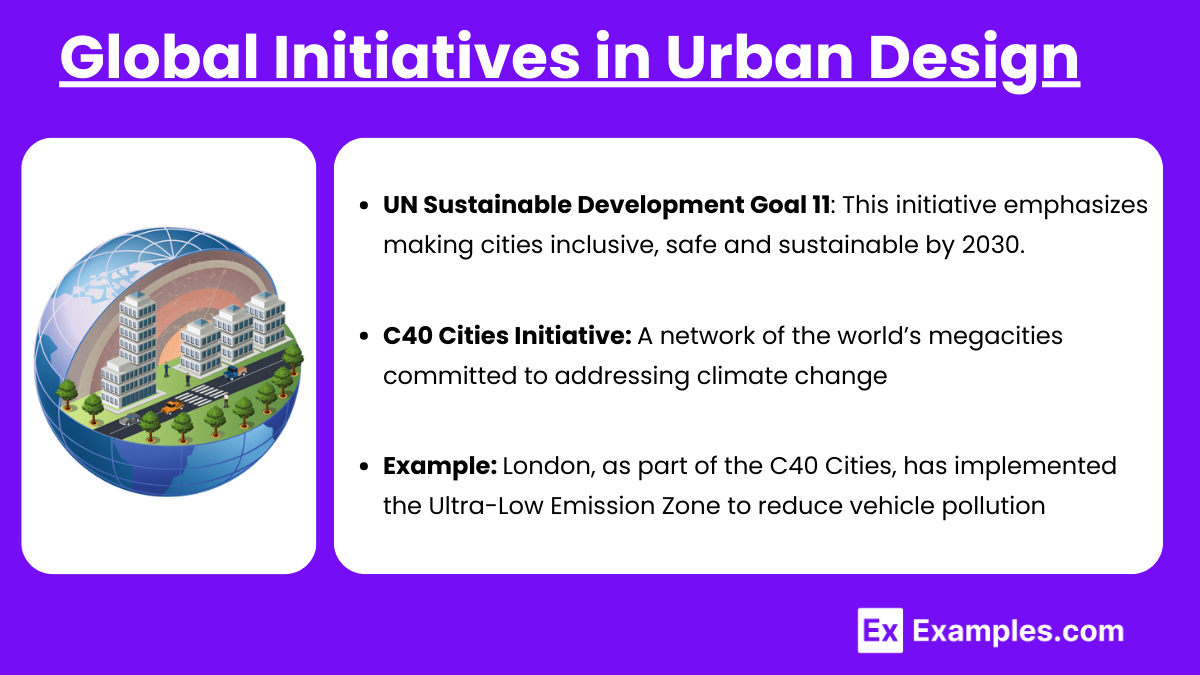
- UN Sustainable Development Goal 11: This initiative emphasizes making cities inclusive, safe, resilient, and sustainable by 2030. It promotes affordable housing, access to public transport, and reducing the environmental impact of cities.
- C40 Cities Initiative: A network of the world’s megacities committed to addressing climate change. Cities in this network share knowledge and best practices to reduce carbon emissions, promote renewable energy, and improve urban sustainability.
- Example: London, as part of the C40 Cities, has implemented the Ultra-Low Emission Zone (ULEZ) to reduce vehicle pollution and encourage the use of electric vehicles.
Examples
Example 1. Green Belt Initiatives
Green belt initiatives aim to preserve natural spaces around urban areas by restricting development and ensuring that urban sprawl does not encroach on agricultural or undeveloped land. Cities such as London and Seoul have implemented green belts to control urban expansion. These green zones act as natural buffers, helping to reduce pollution, manage flood risks, and provide recreational areas for residents. In addition, they encourage higher-density development within the city limits, promoting sustainable urban growth.
Example 2. Transit-Oriented Development (TOD)
Transit-Oriented Development focuses on designing urban areas around public transportation hubs like bus or train stations to create walkable, sustainable communities. By prioritizing public transit, TOD aims to reduce traffic congestion, lower carbon emissions, and decrease dependency on private vehicles. Cities such as Curitiba in Brazil and Portland, Oregon, are examples where TOD has been used effectively. The design encourages mixed-use developments, allowing residents to live, work, and shop near public transport, contributing to more efficient land use and improved quality of life.
Example 3. Smart Cities Initiatives
Smart cities integrate technology into urban infrastructure to improve the quality of life, sustainability, and efficiency of services. Singapore and Barcelona are leading examples of smart cities, where data-driven systems are used to monitor and manage energy use, traffic, waste, and water. These cities use IoT (Internet of Things) technologies to optimize resources, improve public transportation, and increase security through real-time surveillance. The goal of smart city initiatives is to enhance urban living by making cities more adaptive and responsive to residents’ needs.
Example 4. New Urbanism
New Urbanism is a design movement that promotes walkable neighborhoods with mixed-use development, aiming to reduce the dependence on cars. The focus is on creating human-centric urban spaces with a balance of housing, commercial spaces, and public parks within close proximity. Seaside, Florida, is a well-known example of New Urbanism, where the town is designed to foster community interaction through pedestrian-friendly streets and accessible amenities. The emphasis on sustainable, compact living helps improve social cohesion and environmental sustainability.
Example 5. Water-Sensitive Urban Design
Water-Sensitive Urban Design (WSUD) incorporates water management solutions into the urban environment to address issues like flooding, stormwater runoff, and water scarcity. This approach is seen in cities such as Melbourne, Australia, which uses WSUD strategies like permeable pavements, green roofs, and rain gardens to naturally manage stormwater. By integrating natural systems into urban infrastructure, WSUD helps create resilient cities capable of withstanding the impacts of climate change while enhancing urban livability.
Multiple Choice Questions
Question 1
Which of the following urban design initiatives focuses on creating compact, walkable communities centered around high-quality public transportation systems?
A) Smart Cities
B) New Urbanism
C) Transit-Oriented Development (TOD)
D) Garden Cities
Answer: C) Transit-Oriented Development (TOD)
Explanation: Transit-Oriented Development (TOD) is an urban design initiative that emphasizes creating compact, walkable communities built around high-quality public transportation systems. TOD encourages mixed-use development and reduces car dependency, promoting a more sustainable and efficient urban layout. While Smart Cities (A) focus on integrating technology into urban planning and management, New Urbanism (B) promotes traditional city planning principles like walkability and community focus but does not specifically center around public transit. Garden Cities (D) were designed for self-contained communities with green belts but were not specifically transit-focused.
Question 2
Which of the following is a core principle of the New Urbanism movement?
A) Zoning laws that separate residential, commercial, and industrial areas
B) Designing high-rise residential towers to maximize urban density
C) Creating walkable neighborhoods with mixed-use development
D) Establishing green belts around cities to limit urban sprawl
Answer: C) Creating walkable neighborhoods with mixed-use development
Explanation: New Urbanism emphasizes creating walkable neighborhoods with mixed-use developments, where residential, commercial, and public spaces are located within close proximity, reducing the need for cars and fostering a sense of community. Zoning laws that separate different types of land use (A) were actually part of earlier modernist planning, which New Urbanism seeks to move away from. High-rise residential towers (B) are characteristic of modernist urban planning, often promoted by architects like Le Corbusier, and not by New Urbanism. Green belts (D) are more associated with Garden City concepts rather than the urban-focused New Urbanism movement.
Question 3
Which of the following urban design strategies is most associated with promoting climate resilience in cities?
A) Incorporating green roofs and permeable pavements to manage stormwater
B) Expanding highway infrastructure to reduce traffic congestion
C) Promoting suburban development to reduce urban density
D) Encouraging the use of private vehicles for daily commutes
Answer: A) Incorporating green roofs and permeable pavements to manage stormwater
Explanation: Climate resilience in cities is enhanced by incorporating features like green roofs and permeable pavements (A), which help manage stormwater, reduce the heat island effect, and improve urban sustainability. Expanding highways (B) and encouraging the use of private vehicles (D) actually increase urban sprawl, pollution, and carbon emissions, working against climate resilience goals. Promoting suburban development (C) typically leads to increased land use, car dependency, and environmental strain, which is contrary to climate-resilient urban planning practices.

